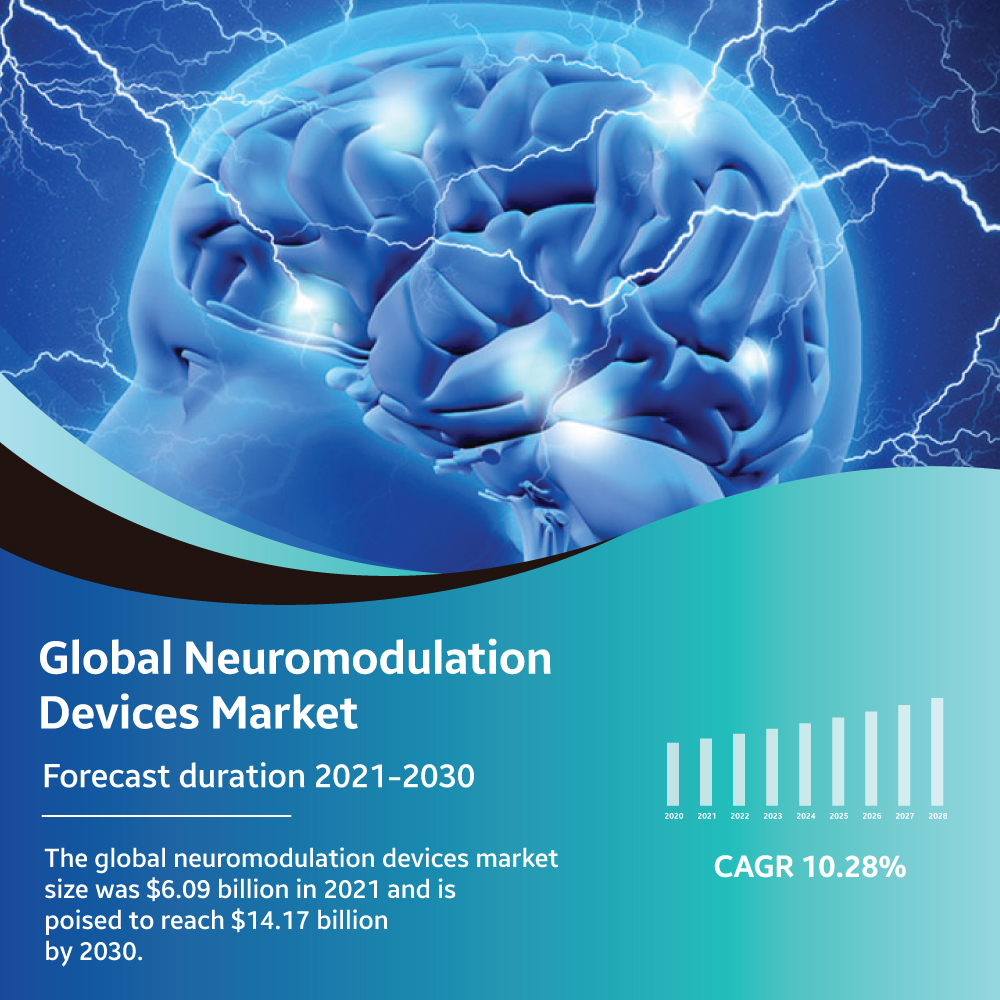Neuromodulation devices are designed to control nerve activity by delivering stimulation, such as in pain treatment. This model, including deep brain stimulators, vagus nerve stimulators, spinal cord stimulators, sacral nerve stimulators, gastric electric stimulators, and peripheral nerve stimulators, cover numerous neuromodulation devices.
The market value of neuromodulation in 2021 was USD 6.09 billion and will reach USD 14.17 billion by 2030 at a 10.28% CAGR During 2021-2030.
Examples of invasive neuromodulation devices include Deep Brain Stimulation (DBS) devices for Parkinson’s disease and essential tremors and Vagus Nerve Stimulation (VNS) devices for refractory epilepsy. Examples of non-invasive neuromodulation devices are Electroconvulsive Therapy (ECT) devices, which are also covered by insurance in the country. The treatment is applied in regular clinical practice to schizophrenia, bipolar disorder, and depressive symptoms.
Market Drivers
One significant aspect that significantly changes the market trends for neuromodulation is the ongoing emphasis of key industry leaders on R&D expenditure for establishing clinical efficacy and extension of the clinical uses of these devices. Neuromodulation devices, for instance, can be used to treat tinnitus. An intermittent magnetic field is sent through the brain by a repetitive transcranial magnetic stimulator, a non-invasive technique that can reduce tinnitus.
The prevalence of neurological, pulmonary, and other disorders is rising worldwide. The WHO estimates that 40–50 million people globally have epilepsy, while Johns Hopkins Medicine estimates that 12 million people do. With the frequency of neurological, respiratory, and other disorders rising, the market for neuromodulation devices is expanding globally.
Restraints
Their dangers and side effects hamper the development of the global market for neuromodulation devices. The body can experience several negative effects from neuromodulation implant surgery, including allergies and hoarseness. Due to the electrical impulses they produce, neuromodulation devices also come with significant hazards.
Additionally, the availability of other treatment options, such as medications and other surgeries (such as Pallidotomy), may restrain the market growth.
Opportunities
In the United States, neuromodulation devices have previously been given FDA approval to treat significant neurological conditions such as epilepsy, depression, movement disorders, and others. By the end of 2035, it is anticipated that considerable improvements in the field of neuroanatomical networks, together with significant advancements in miniaturization, material science, & energy storage, will cater to a wide range of market growth potential.
Market Segmentation
Product Type Insights
On the basis of product type, the market is segmented into spinal cord stimulators, deep brain stimulators, sacral nerve stimulators, vagus nerve stimulators, transcranial magnetic stimulators, and others.
In 2021 the spinal cord stimulator maintained the maximum market position with 40.0% of the revenue share due to the growing adoption of spinal cord stimulators utilized for curing chronic pain and nerve pain.
Application Insights
In 2021, the Parkinson’s disease segment significantly held a maximum position with a revenue share of 25.0% due to the absence of effective treatments for the disease and the high product efficacy in treating epilepsy. Parkinson’s disease is a long-lasting neurodegenerative brain condition that impairs movement. Parkinson’s disease was present in roughly 6.2 million persons in 2020, per the Global Burden Diseases (GBD) survey.
The chronic pain segment will grow at the fastest rate of 11.3% over the forecast period. It is due to the rise in the prevalence of chronic diseases, the increase in private player investments in the field of Neurotherapy, and the expansion of research and development activities in the industry.
End-use Insights
The market for neuromodulation is segmented into hospitals and ambulatory surgery centers (ASCs), clinics and physiotherapy facilities, and others based on end-use. The hospitals and ASCs segment had the highest revenue share of over 50% in 2021.
Regional Insights
In 2021, North America considerably ruled the entire regional market with 45.0% of the revenue share. The market expansion in North America is fuelled by an increase in patients with neurological illnesses, driving up demand for neuromodulation devices, greater competition among market participants, and considerable investment in research & development to create new therapeutic options. The continual increase in patients with neurological illnesses from U.S. and Canada has fuelled the market for neuromodulation devices.
Due to the increased prevalence of neurological illnesses, the region’s booming healthcare infrastructure, increasing government support, and a rising prevalence of startups, Asia Pacific will grow at the quickest pace of 10.6%
Key Players
- Abbott Laboratories
- LivaNova
- Medtronic
- Boston Scientific Corporation
- Nevro Corporation
- NeuroSigma, Inc.
- Synapse Biomedical
- NeuroPace, Inc.
- Bioness
- Soterix Medical
- Neuronetics, Inc.
- BioControl Medical
- Integer Holdings Corporation
- GTX Medical
- Helius Medical Technologies
- Bioinduction
- Neuronano
- GiMer Medical
- MicroTransponder
- BlueWind
The market value of neuromodulation in 2021 was USD 6.09 billion and will reach USD 14.17 billion by 2030 at a 10.28% CAGR During 2021-2030. Over the forecast period, an increase in the prevalence of neurological illnesses is anticipated to fuel market expansion for neuromodulation devices.
I am a professional writer and blogger. I’m researching and writing about innovation, Entertainment, technology, business, and the latest digital marketing trends click here to go website. Follow my blog here & Visit my website here.



